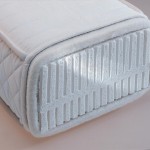Our tips on how to choose the ideal natural latex mattress for you

The Samar Comfort Plus from Prolana
Your mattress needs to match the way you sleep – side, back or front.
If you sleep on your side all or part of the time, you really need a mattress with a soft and yielding surface.
Your shoulders and hips will then sink into the mattress the most, helping the pressure sensitive quality of the natural latex to keep your spine nicely aligned in its natural rest shape and position.
This total relaxation of the spine and its muscle groups is the key to fully restorative sleep.
In our experience, the dominant causes of neck, shoulder, back and hip discomfort from sleep are not having a mattress that matches the way you sleep or sleeping on a mattress of deteriorating condition.
Surface tension is distinct from orthopaedic grade. So, you can select one of our natural latex mattresses with just the right grade for you – soft, medium or firm – as they all have soft and yielding surfaces.
Most sprung mattresses and our combined natural latex and coconut coir mattresses tend to have firmer surfaces.
If you sleep on your front or back you may need a mattress with a firmer surface tension
If you sleep mainly on your back or front, but also to some extent on your side, you should still probably opt for a mattress with a soft and yielding surface. Our natural latex mattresses of medium or greater depth should prove ideal for this combination of sleep.
As a front or back sleeper, your preference is likely to be for a mattress with relatively firm surface tension, to help maintain good alignment of the spine in its natural rest shape and position.
Our natural latex and coconut coir mattresses have firmer surface tensions and medium to firm orthopaedic grades, due to the coconut coir which is both firm and springy.
What depth of mattress would be right for you?
Depth is really a measure of comfort, as the greater the depth the better the pressure sensitive performance of the natural Latex in the mattress core.
If you are above average weight and height, it would be wise to select a mattress of greater depth, but if you are of average weight and height, you will find the mid-range mattresses to be perfectly comfortable, with very effective orthopaedic performance.
Do you and your partner have different needs?
If you and your partner need mattresses with different characteristics, we have a solution for you.
Providing they are of the same depth, we can combine any two single mattresses in one partners cover, which will help to bind the two mattresses together and make the join between them difficult to detect.
So, you could each have mattresses with different surface tensions and orthopaedic grades.
How to keep the temperature and moisture down
If you are concerned about being too warm or about the absorption of moisture, be sure to select a mattress that has a fleecing around its core.
We use organic Cotton and organic Merino LambsWool for our fleecing, as both are extremely effective at maintaining constant even temperatures, with the Cotton being the cooler, and the absorption and regulation of excess moisture.
House Dust Mites thrive in warm, moist conditions, but, fortunately, are unable to colonise in natural latex.
Even so, good ventilation is an important part of mattress hygiene, which is why we recommend slatted bed bases for natural latex mattresses.
How often should you change your mattress?
Mattress materials and structure may be designed to last for anything from 5 to 15 years, but House Dust Mite infestation will probably cause the mattress to deteriorate more quickly than this and to become unhygienic.
The Mites take les than 6 months to colonise and so it is important to protect a new mattress from the very outset.
The protection we offer is Neem oil, entirely naturally made from the seed and fruit of the Neem tree, which can be applied to your new mattress as it is being hand made.
Mattress protectors can also be used to protect the surfaces of mattresses and these have the advantage of being machine washable at 60 degrees, the temperature required to eradicate the House Dust Mites.
If the problem with your mattress is recent, it may help to identify what has changed?
If your mattress is beginning to deteriorate, perhaps compacting and dipping or you can now feel the springs quite distinctly, this may be the cause of the onset of recent discomfort, but that does not mean the structure and firmness of that mattress was wrong for you.
This might only be the case if you have always found your mattress to be uncomfortable or to be causing you to wake with aches and pains in the neck, shoulders, back or hips.
If your mattress has been comfortable and has not caused any discomfort, it may prove wisest to select a new mattress with a fairly similar grade of firmness and surface structure.